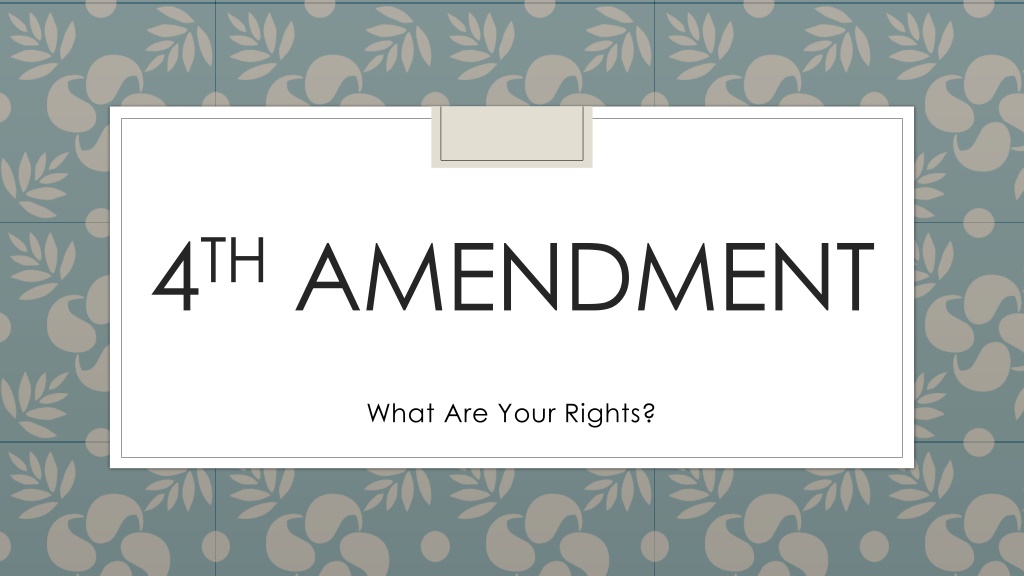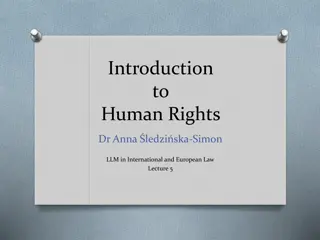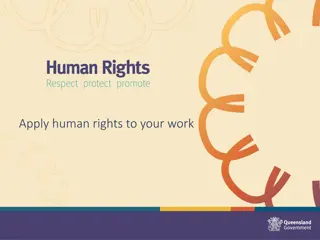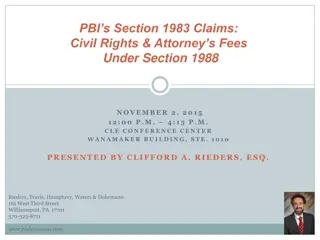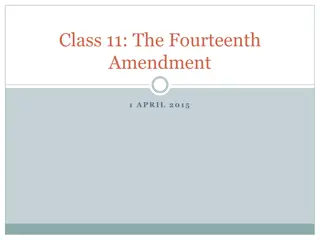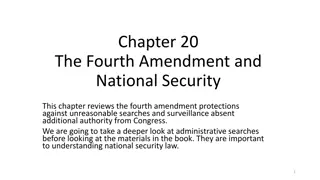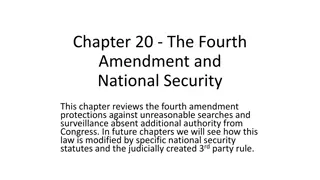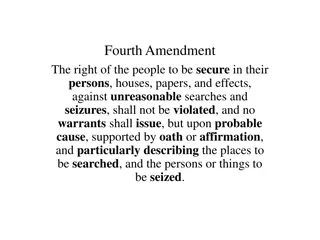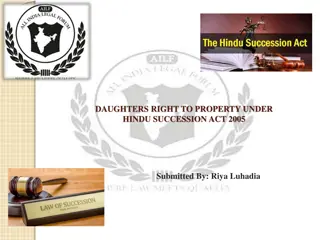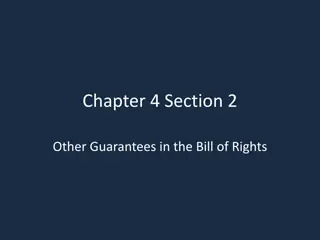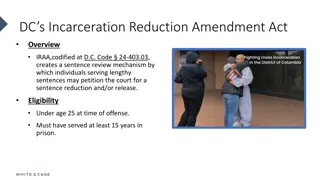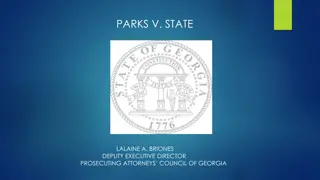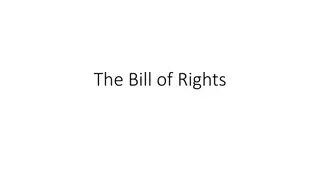Understanding Your Rights Under the Fourth Amendment
Exploring the rights to privacy granted by the Fourth Amendment, this lesson delves into scenarios involving searches and seizures in various settings like schools, cars, and homes. Students will learn how these rights apply differently depending on the location and items being searched.
Download Presentation

Please find below an Image/Link to download the presentation.
The content on the website is provided AS IS for your information and personal use only. It may not be sold, licensed, or shared on other websites without obtaining consent from the author. Download presentation by click this link. If you encounter any issues during the download, it is possible that the publisher has removed the file from their server.
E N D
Presentation Transcript
4THAMENDMENT What Are Your Rights?
Todays Objective After today s lesson, students will be able to Explain what rights to privacy are provided by the 4thAmendment Essential Skill: To explicitly assess information and draw conclusions
Discuss What right do you have to keep your stuff private? How does this right change depending on whether you are at home or at school? Does it change depending on what it is that you are trying to keep private?
Rank The back pack we just searched School locker in main hallway The contents of a purse in school locker Gym locker in girls locker room Bathroom stall with closed door Clothing, including pockets and underwear, while you re wearing it Clothing that you re not wearing (ex. Coat draped on back of chair) Bodily fluids such as urine and blood The contents of your cell phone
The Fourth Amendment The right of the people to be secure in their persons, houses, papers, and effects, against unreasonable searches and seizures, shall not be violated, and no warrants shall issue, but upon probable cause, supported by oath or affirmation, and particularly describing the place to be searched, and the persons or things to be seized
Schools, Cops, Cars, and the Constitution Read through each case assigned to you Decide how it should be decided List your reasons and be prepared to present to the class
Case #1 Gail Atwater was driving her car home from a soccer match when she was stopped by Lago Vista (TX) police officer Bart Turek. Officer Turek observed that Atwater and her two children (ages 4 and 6) were not wearing seat belts. This was a violation of the Texas Transportation Code. Violation of this section of the Code provided for a fine of between $25 and $50 upon conviction. Turek had stopped Atwater several weeks earlier for another traffic law violation. This time he told her she was going to jail. Atwater was arrested for the seatbelt violations as well as for driving without a license and failing to provide proof of insurance. (Staff members from a social service agency were called to the scene and took temporary custody of the two young children.) Atwater was handcuffed and taken to the police station where she was kept in a cell for an hour before being released after posting bond before a magistrate. At trial she pleased guilty to the seat belt offenses and paid a $50 fine. The other two charges were dismissed when it was clear that she in fact had a license and proof of insurance (but happened not to be carrying them with her when she was stopped). Was Officer Turek s arrest (seizure) of Atwater legal?
Atwater v. Lago Vista (2001) A warrantless arrest for a misdemeanor does not violate the Fourth Amendment Decision: A balancing of the individual and governmental interests is not required where there is probable cause to arrest an individual Dissenting Opinion: Probable cause is only one condition that is factored in when making a determination for the warrantless arrest of fine-only offenses
Case #2 The City of Indianapolis (Indiana) began operating roadway checkpoint programs through its police department in August of 1998 in order to interrupt the flow of illegal narcotics in the area. During the first four months of the program drug interdiction roadblocks were set up six times at various points in the city. Police stopped 1,161 vehicles at the roadblocks and arrested 104 motorists. About half of the arrests were for narcotics offenses while the other half were for other offenses. The police department selected the locations, told the public when (but not where) the roadblocks would be set up, and followed the following protocol at the roadblocks: a predetermined number of vehicles are stopped and processed while other traffic continues unimpeded. After all the stopped cars are processed, they are allowed to leave, unless there is a specific reason found to hold a particular vehicle. Once those vehicles leave, the same predetermined number of vehicles is stopped again and the process repeats. As part of the stop officers ask for license and registration and tell drivers they have been stopped at a drug checkpoint. Police look for signs of impairment and do a visual inspection of the vehicle from the outside. A drug detection dog walks around the car. If the dog alerts, police are authorized to do a warrantless search of the car. Two people who have been stopped bring a class action suit on behalf of themselves and others asking that this practice be stopped. Are these roadway checkpoint stops legal?
Indianapolis v. Edmond (2000) Drug roadblock stops are illegal under the Fourth Amendment Decision: Recognizes limited exceptions to the rule that a stop and search requires individualized suspicion in order to be reasonable (Border patrol, etc) but there is a specific purpose, not detection of ordinary criminal activity, attached to the law enforcement practice that makes the search and seizure reasonable. Dissenting Opinion weighing the gravity of the public concerns served by the seizure, the degree to which the seizure advances the public interest, and the severity of the interference with individual liberty. A stop will interfere 2-3 minutes tops
Case #3 A Maryland state trooper stopped a speeding car. Approaching the car at the side of the road, the trooper noticed that Wilson, a passenger, was particularly nervous. The trooper ordered Wilson out of the car. As Wilson exited the car a quantity of cocaine fell to the ground. Wilson was arrested and charged with possession and intent to distribute. The trial court granted Wilson s motion to suppress the evidence, ruling that the trooper s order was an unreasonable seizure under the Fourth Amendment. Should the trial court s decision be reversed on appeal?
Maryland v. Wilson (1997) An officer making a traffic stop may order passengers to step out of the car. Decision: Held that the Mimms rule (Pennsylvania v. Mimms), where an officer may order the driver of a lawfully stopped car to step out of the car, also extends to passengers of that car. Their safety is more at stake during stops where other passengers are in the vehicle. This small inconvenience for the passenger is found to be reasonable when weighed against the public safety interest of the officer. Dissenting Opinion The dissent argues that the majority s ruling is too broad. Officers can ask anyone without any probable cause to believe they may be dangerous.
Case #4 An Iowa police officer stopped Knowles for speeding and gave him a traffic ticket (citation) rather than arresting him. The officer then conducted a full search of the car, without either the consent of the driver or probable cause. The trooper found drugs and arrested Knowles. Knowles asked the trial court to suppress the evidence on the theory that since he had not been arrested there could be no warrantless search incident to a lawful arrest. Because an Iowa law allows officers to conduct a full-blown search of an auto and driver after issuing a citation instead of making a custodial arrest, the evidence was allowed and he was convicted. Should the conviction be overturned on appeal?
Iowa v. Knowles (1998) Conducting a full-blown search subsequent to a speeding citation violates the Fourth Amendment Decision: Relying on U.S. v. Robinson, the Court found that the search in this case did not fall within the two rationales permissible under the search incident to arrest exception. The first step is to determine whether there is a need to disarm the driver in order to take him in to custody. The second rationale for the search, to discover and preserve evidence, is not an issue in this situation. No Dissenting Opinion
Case #5 During a routine traffic stop a Wyoming Highway Patrol officer noticed a hypodermic needle in the driver s shirt pocket. The driver admitted using the needle to take illegal drugs. The officer then searched the passenger compartment for contraband, removing and searching the purse of a passenger. The officer found drugs in her purse and arrested her, too. The passenger asked the trial court to suppress all evidence found in her purse, arguing that it was illegal to search the purse of a passenger for whom the police had no independent probable cause. The Wyoming courts agreed with her. Should the state supreme court s decision be overturned on appeal?
Wyoming v. Houghton (1999) Law enforcement officers may lawfully search the belongings of all passengers in a car where there is probable cause to believe there is evidence of criminal activity Decision: Court based its decision on the earlier case of U.S. v. Ross, which held that the warrantless search of the defendant s belongings in his trunk. The Court also stated that there is a reduced expectation of privacy with passengers and their belongings when they transport them in the public. Dissenting Opinion: the object of the search and the places in which there is probable cause to believe that it may be found is with the misconduct of the driver, which can not be extended to the passengers
Supreme Court Debates You will be participating in a one-on-one debate After randomly choosing a topic, you and your partner will determine which side of the issue you will defend. There will be two people debating about each topic from opposing perspectives.
Written Materials Requirements (50 points credit): All items should be typed (approx. 3 pgs. total). 1.Constructive speech: Your speech should be no more than 2 minutes long. (30 points) -Introduction/ Thesis Statement: need to include an introductory paragraph with at least 3 main reasons/support themes- more details and specific evidence should be included in the body of your speech -Final Statement: Summarize your main points and persuade class in closing statement -In-text citations: For use of specific facts, statistics, quotes in your speech. Any sources you cite must be included in your bibliography. (20 points for typed speech) 2. Cross-Examination Questions: Type a list of 3-4 potential questions you could use during your cross-examination time. (10 points) 3. Works Cited- You must use and cite 4 sources in MLA format. Use CQ Researcher current issues , or CQ Supreme Court collection (10 points)
Debate Format: (50 points) Each debate will take about 15 minutes total. Times must be adhered to; each portion of the debate will be timed(timer will be projected). You may use a 5x7 card only in the debate.. 1)Person A- 2 minute constructive speech (this is the person who supports the issue) 2)Person B- 2 minutes constructive speech (this is the person who opposes the issue) 3) Person B cross examines Person A- 2-3 minutes (Questions will be asked and answered during this time) 4) Person A cross examines Person B- 2-3 minutes 5)Person A Rebuttal/Final Statement- 1 minute (the rebuttal should refute specific points that the opponent has made and restate points you have made that were not challenged by the other side. 6) Person B Rebuttal/Final Statement- 1 minute
